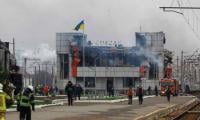The ambulance driver was overwhelmed. During Karachi’s 2024 heatwave, he could not cope with the sheer number of bodies that needed transporting to the morgue. “My car did not stop, I had 10 to 11 calls per day", he told me. “I was shifting one patient and would get another call.”
Last year, as the combination of extreme heat and stifling humidity made it feel like more than 50 C, Karachi became a furnace. Much of the city’s population lives in crowded, poorly-ventilated neighbourhoods with little shade. Many of these neighbourhoods endure near-constant load-shedding, sometimes for more than 12 hours a day. Residents, many of whom are informal workers, had no choice but to keep labouring in the extreme heat. And yet, despite Karachi’s population of more than 20 million people, the Sindh Provincial Disaster Management Authority reported just 56 heat-related deaths – a surprisingly low figure given the extreme conditions, and one that groups like the charitable Edhi Foundation, which runs a free-of-charge ambulance and morgue service in Karachi, have questioned.
Heatwave deaths are difficult to capture in any country. Most people don’t die directly from the heat. Instead, underlying chronic conditions like hypertension or diabetes, more often suffered by older people, leave some individuals more vulnerable, often leading to a heart attack or stroke. That’s why heatwave deaths in many countries are measured by calculating the 'excess' number of deaths – those above the expected number during a given period. But in Pakistan, where fewer than five per cent of fatalities are formally registered at all due to cost and logistical barriers, any comprehensive analysis of heatwave deaths is impossible.
Parts of Pakistan are in the heatwave season once again. Over the past 30 years, the number of days classed as heatwaves has increased nearly fivefold, yet there remains little transparency about the number and causes of deaths during these events, as documented in our recent Amnesty International report. Pakistan is the world’s fifth-most vulnerable country to climate disasters, but without a clearer understanding of how many people are dying and why, the government cannot address the issue.
It is well-known that older people are most at risk from extreme heat – yet in Pakistan, many of them are forced to continue working in harsh conditions. Many I spoke to continued working during the heatwave and said they simply couldn’t afford to stop. I frequently found that they worked in jobs with no relief from the heat, standing guard outside a petrol station in the scorching sun, or sweating over stoves in sweltering kitchens – despite the exhaustion and health risks. With no government support and little family assistance or alternative employment, stopping meant starving.
Pakistan offers little in the way of social protection for its older population. There are no universal support schemes for those who can no longer work, and the country’s two existing pension programs barely reach 20 per cent of older adults, leaving the vast majority without a safety net.
Beyond the lack of financial assistance to help older people reduce or stop working, the government also fails to provide crucial protections for those who stay at home during heatwaves. One of the simplest ways to prevent heat-related illness is by using a fan, yet in Karachi’s overcrowded, low-income neighbourhoods – where air conditioning is a luxury enjoyed by very few people – this basic relief was often impossible. During the hottest days, residents told me that prolonged power cuts left them struggling in suffocating heat, with no way to cool down. For many, it was a death sentence.
A critical immediate action is ensuring an uninterrupted electricity supply to residential areas during heatwaves, providing a lifeline to those at home.
Despite the official death toll from the Karachi heatwave, information from the Edhi Foundation tells a different story. The organisation told Amnesty International that its morgues receive around 60 bodies on a typical day. During June and July 2024, at the height of the heatwave, this number increased to more than 100, peaking at 141 on June 28, 2024. They also transported hundreds of patients suffering from heat-related illnesses to hospitals.
Health facilities were not prepared for the heatwave. I spoke to several families who took their loved ones to primary care facilities, only to be turned away. Many were told that they lacked the skills or resources to treat heat-affected patients. Many also struggled to find an available ambulance.
Healthcare workers in Karachi hospitals told us they were overwhelmed by the surge in patients during the heatwave: beds were full, with many patients forced to wait hours before being admitted for treatment. In some cases, these delays led to complications – and often, to death.
Our investigation uncovered a further troubling trend: many deaths that appeared to be caused by heat-related issues were never officially recorded as such. Many deaths were put down to natural causes, with several listed as heart attacks or respiratory failure, which raises alarming questions. Our research into 2022 also suggested issues in record-keeping. According to official data, not a single one of Punjab’s 120 million residents who endured 50°C heat in 2022 died from heat-related causes. For the Pakistani government to implement meaningful reforms, it must first understand who is most affected – and how – when heatwaves occur.
The Pakistani government can improve data collection during heatwaves by waiving fees for death registration and improving data-sharing between hospitals, morgues, and government agencies to ensure accurate death records. It must also provide primary healthcare facilities with the necessary training, equipment, and medications to ease the burden on city hospitals.
While Pakistan bears little responsibility for global climate change, it has a duty to protect citizens from its devastating consequences. It must seek international assistance if it’s required, and high-income, high-emitting countries that bear responsibility for the crisis must provide climate finance to help. Climate change is not an issue for the future, it is an issue impacting Pakistanis with greater frequency and intensity today. If we want to live in a world where older people’s lives are respected and protected, the government needs to act now to make that a reality.
The writer is a researcher with Amnesty International’s Crisis Response Programme.















